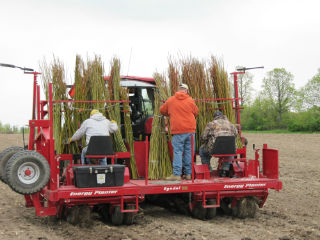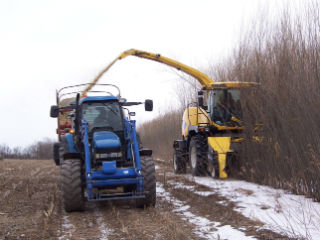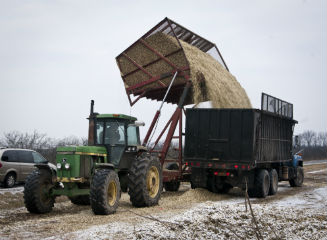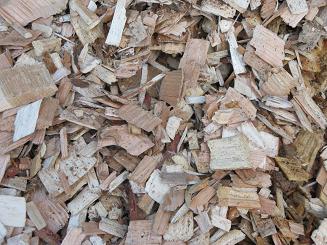
Farmers growing shrub willow for bioenergy are helped by a BCAP project in New York State that aims to make the biomass crop more financially viable.
Table of Contents
- Introduction
- The BCAP Project
- Why Shrub Willow?
- Obstacles to Commercial Willow Industry
- Finding Solutions
- Building a Market for Willow
- How the Region Benefits
- Background
- Summary
- For Additional Information
- Contributors to This Article
Introduction
The USDA Biomass Crop Assistance Program (BCAP) was designed to expand bioenergy feedstocks beyond existing cash crops by encouraging both the establishment of new supplies of biomass as well as the collection of existing but underutilized biomass. The program assists landowners with the establishment, maintenance, and harvest of non-food, non-feed biomass dedicated for energy production.
Commercialization of shrub willow grown for as a source of renewable energy has taken several steps forward via a USDA BCAP project in northern New York State. The project is helping to overcome several hurdles faced by growers, including high establishment costs, uneven cash flow for growers, and an uncertain market.

The BCAP Project
In 2012, the U.S. Department of Agriculture established the BCAP project area #10 for willow biomass crops in nine counties of northern New York. During summer and early fall of that year, almost 1,200 acres were enrolled in the program. About 70% of the area is new willow crops that were planted in the spring of 2013. The remaining 30% is willow crops that were planted several years earlier and recently made eligible to be enrolled in the BCAP project. Eight landowners are now taking part. All of the willow biomass grown will be used to produce renewable energy at facilities owned by ReEnergy Holdings LLC in northern New York.
Why Shrub Willow?
Willow biomass crops are a carbon-neutral renewable form of energy that can be grown on marginal land. The net energy ratio for willow has been shown to range from 18:1 to 43:1, which means that for every unit of fossil fuel energy invested in the production, harvest, and delivery of willow, about 18 to 43 units of energy are stored in the willow biomass chips that are delivered to a renewable energy facility. The net energy ratio is highest when facilities are closer to the field (about 15 miles) where the willow is grown.

Although willow biomass is unlikely to be the primary source of woody biomass for renewable energy generation in the region, it has the potential to be an excellent complement to sources such as forest residue and can help to diversity agricultural production. Willow biomass crops can be grown on marginal land in northern NY and across the region. This provides landowners with another option for generating income from this lower quality land.
Obstacles to Commercial Willow
There are several hurdles to the establishment of a viable industry of willow biomass crop production for biofuel. The first is the high cost of crop establishment, which is typically between $800 and $1,000 per acre. The second is cash flow that can be delayed and uneven because the crop is only harvested every three to four years. The third is an uncertain market for the shrub-willow biomass.
Finding Solutions
BCAP directly addresses the first two barriers and indirectly assists in resolving the third barrier. The BCAP provides financial assistance to growers—$1.23 million in direct financial support—to establish and produce biomass crops within the nine-county project area. Landowners participating in the project are eligible to receive cost-share payments for the establishment of willow biomass crops, and annual rental payments for years when there is no crop harvest. The funds from the USDA will be about evenly split between cost-share payments and annual rental payments.
Helping to make the establishment of shrub willow more cost-effective for landowners, Double A Willow, a commercial nursery in Fredonia, New York, grows about 150 acres of willow nursery stock, which is enough to establish thousands of acres of willow each year using genetically improved cultivars.

The recent acquisition of two different types of European planters designed specifically to plant woody crops from hardwood cuttings should help lower establishment costs and improve planting efficiency. There are currently about 40,000 acres of willow grown for biomass in Europe so the industry here can benefit from those experiences. NEWBio is making an Egedal planter from Denmark (owned by Double A Willow) available to landowners who want to establish willow at a reduced cost. Celtic Energy Farm and the State University of New York’s College of Environmental Science and Forestry also own two- and four-row step planters that were manufactured in Europe and are potentially available for use.
To harvest willow biomass more effectively, a single-pass cut-and-chip harvesting system has been developed based on a New Holland forage harvester and a cutting head specially designed for woody crops. The system is currently available through New Holland’s dealer network. The U.S. Department of Energy and the New York State Research and Development Authority (NYSERDA) provided essential support for their development.
Celtic Energy Farm, based in Maspeth, New York is managing more than 1,000 acres of shrub willow. It has a single-pass cut-and-chip New Holland harvester, which is available to other growers in the program at a reduced rental cost because NEWBio provided some support for the cutting head.
Building a Market for Willow
A secure market for the project is important for overcoming the uncertainty of commercial production of a perennial crop like willow biomass on a fixed price contract basis. Over the length of the eleven-year project, 100,000 – 120,000 green tons of biomass should be produced. ReEnergy has agreed to purchase all of the willow biomass produced from the acreage in the BCAP program over the next eleven years. ReEnergy recently completed the retrofit of a coal-fired power plant at the Fort Drum, NY army base to use wood chips as its fuel source and also owns other facilities in the region that use woody biomass.

How the Region Benefits
The project developers estimate that growing 1,200 acres of willow biomass will create about eight to ten jobs in the region. After the project is completed, the willow crops will still be able to produce biomass for another decade. In addition, the purchase of willow to generate renewable energy will inject about $3 million into the local economy over the course of the project.
Background
SUNY’s College of Environmental Science and Forestry has been working since 1986 on research and development of willow as a sustainable crop for bioenergy and bioproducts. It’s the longest running and largest such program in North America. The latest focus has been on creating a commercial industry to bring the environmental and economic benefits from this type of industry to people in the region.
Summary
The BCAP project is working to make shrub willow commercially viable as a renewable energy crop and to extend its benefits throughout northern New York. By giving landowners financial and technical support, the project helps them weather the volatile early stages of a nascent industry. BCAP also provides specialized planting and harvesting equipment, and on the other end of the spectrum is helping to develop the markets necessary for commercial success.
For Additional Information
- Biomass Crop Assistance Program for Central and Northern NY
- Research Summary: Sequestration of Carbon by Shrub Willow Offsets Greenhouse Gas Emissions
- Mission Alignment, Biomass, October 25, 2013.
Contributors to This Article
Authors
-
Timothy Volk, Senior Research Associate, Department of Forest and Natural Resources Management, State University of New York College of Environmental Science and Forestry
-
Susan J. Harlow, Freelance Journalist
Peer Reviewers
- Eric Fabio, Cornell University
- Michael Jacobson, Professor of Forest Resources, Penn State University
 The Northeast Woody/Warm-season Biomass Consortium – NEWBio is supported by Agriculture and Food Research Initiative Competitive Grant no. 2012-68005-19703 from the USDA National Institute of Food and Agriculture.
The Northeast Woody/Warm-season Biomass Consortium – NEWBio is supported by Agriculture and Food Research Initiative Competitive Grant no. 2012-68005-19703 from the USDA National Institute of Food and Agriculture.
Led by Penn State University, NEWBio includes partners from Cornell University, SUNY College of Environmental Science and Forestry, West Virginia University, Delaware State University, Ohio State University, Rutgers University,  USDA’s Eastern Regional Research Center, and DOE’s Oak Ridge National Laboratory and Idaho National Laboratory.
USDA’s Eastern Regional Research Center, and DOE’s Oak Ridge National Laboratory and Idaho National Laboratory.
